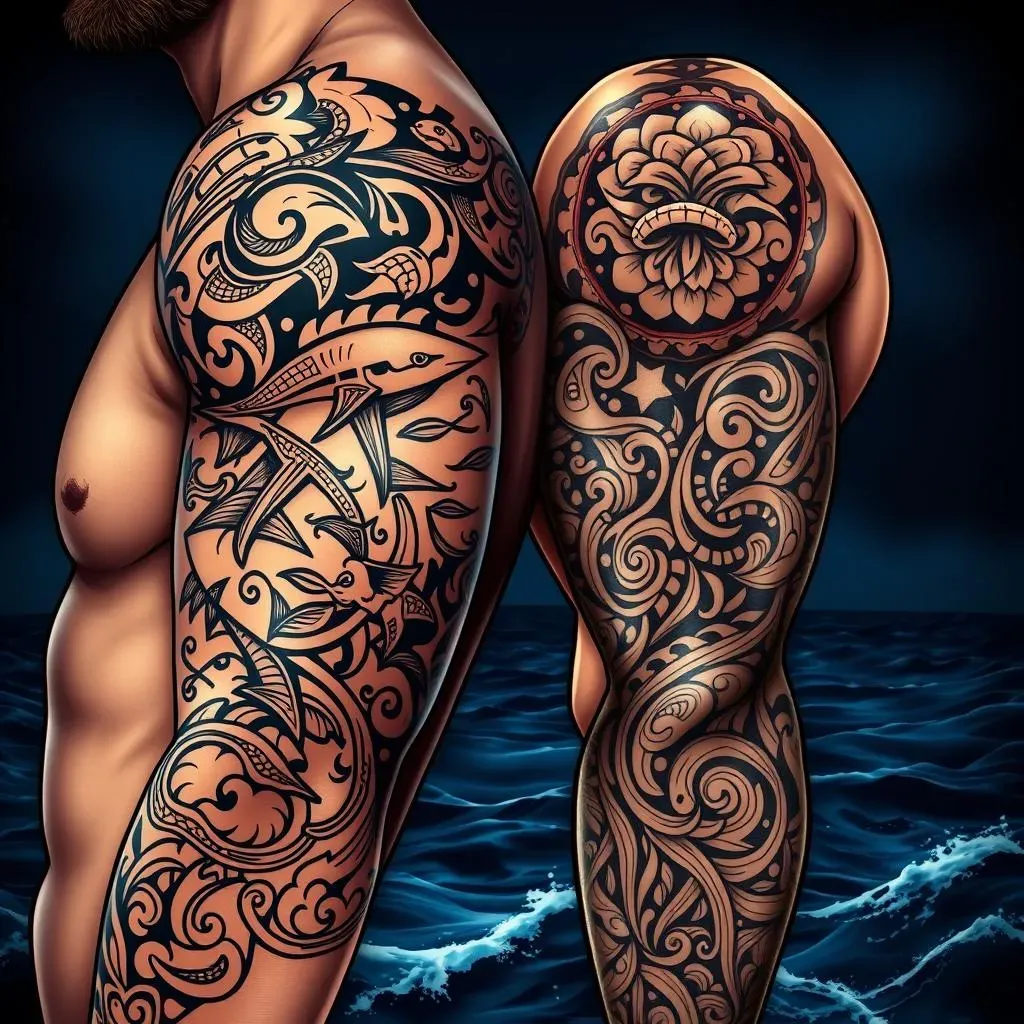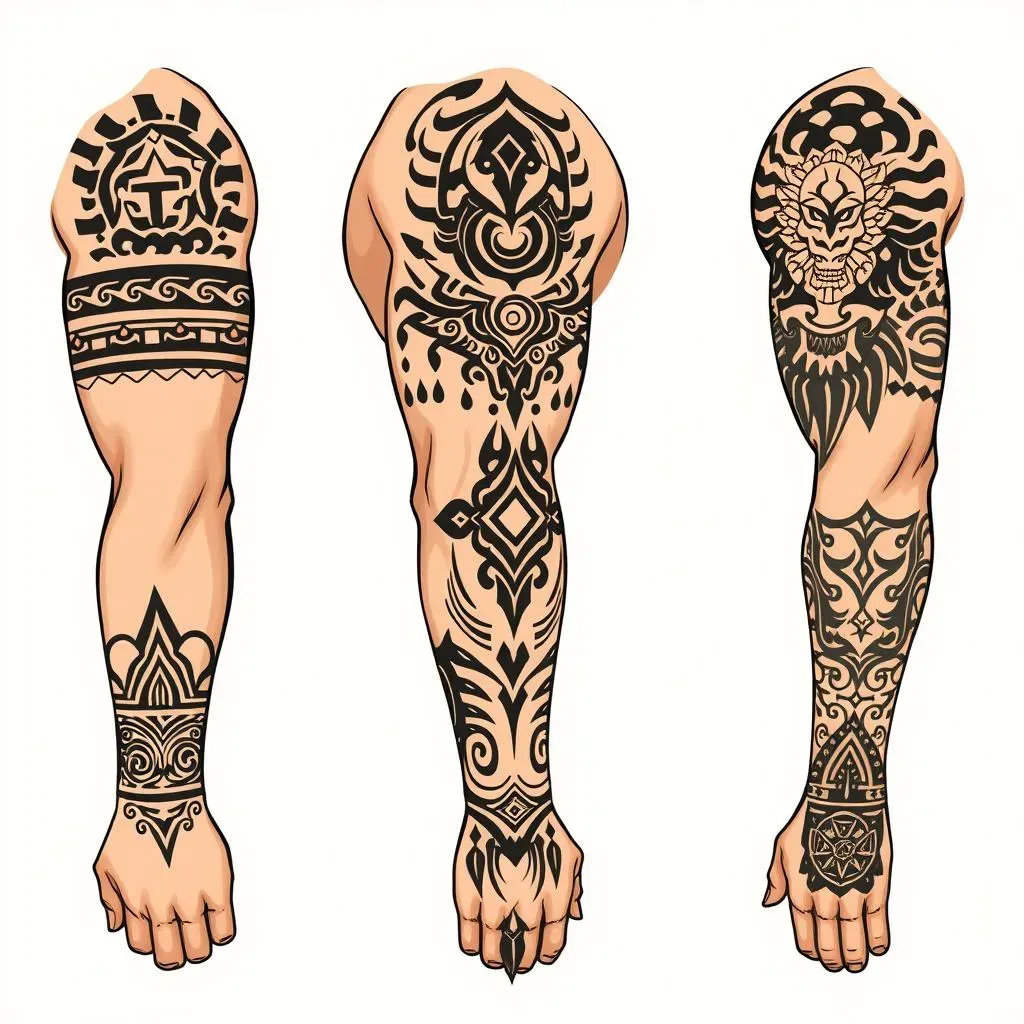Table of Contents
Thinking about getting a tattoo? Want something bold, meaningful, and uniquely you? Then prepare to explore the awesome world of tribal tattoo designs for men's arms! This article is your ultimate guide to navigating this exciting style. We'll journey together through a diverse range of tribal designs from around the globe, examining their rich histories and cultural significance. Learn how to choose the perfect design, size, and placement on your arm to truly make a statement. We'll also cover essential aftercare tips to ensure your new ink looks its best for years to come. Get ready to discover the perfect tribal tattoo design that reflects your personality and unleashes your inner warrior. Let's dive in!
Exploring the World of Tribal Tattoo Designs for Men's Arms
Exploring the World of Tribal Tattoo Designs for Men's Arms
Let's embark on a visual adventure! Tribal arm tattoos are incredibly diverse. Think bold, black ink designs with sharp lines and intricate patterns. They're not just about aesthetics; they often carry deep cultural meanings. For example, Polynesian tribal tattoos, like those from Samoa or Hawaii, of ancestry, status, and achievements. These designs frequently incorporate powerful symbols of nature, like sharks, turtles, and waves, reflecting the islanders' close connection to the ocean.
Tribal Style | Cultural Origin | Common Symbols |
|---|---|---|
Polynesian | Pacific Islands | Sharks, turtles, waves |
Maori | New Zealand | Spirals, curves, geometric shapes |
Aztec | Mexico | Sun, gods, animals |
But the world of tribal tattoos extends far beyond Polynesia! , for instance, are known for their intricate carvings and swirling patterns, representing family lineage and spiritual beliefs. Similarly, Aztec designs from Mexico boast powerful symbols of sun gods, warriors, and animals. These tattoos are a visual testament to a rich cultural heritage. And we haven't even scratched the surface yet! There are countless variations within these styles, and many other tribal traditions to explore.
- Native American
- Celtic
- African
Many modern tribal designs blend elements from different cultures, creating unique and personalized pieces. Think about a design that incorporates elements from multiple traditions or even incorporates personal symbols. For smaller designs, check out our guide on to get some inspiration. This approach allows you to create something truly individual, while still honoring the rich history of tribal art.
Whether you’re drawn to the bold simplicity of a single tribal armband or the powerful narrative of a full sleeve, careful consideration of the design's meaning is crucial. Remember, you're not just getting a tattoo; you're wearing a piece of history and culture. For more ideas, explore our collection of , which showcases a wide variety of styles and sizes.
Choosing the Perfect Tribal Tattoo Design for Your Arm: Style, Size, and Placement
Choosing the Perfect Tribal Tattoo Design for Your Arm: Style, Size, and Placement
Picking Your Style
So, you're ready to commit to some awesome tribal ink? Fantastic! But before you even think about the tattoo parlor, let's talk style. The beauty of tribal tattoos is their diversity. Do you want the bold, sweeping lines of Polynesian designs, or the intricate curves of Maori art? Maybe the powerful symbolism of Aztec imagery speaks to you? Our guide on has tons of examples to spark your imagination. Consider what resonates with you—is it the cultural significance, the visual impact, or a combination of both?
Remember, browsing different styles is key to finding what truly fits your personality. Don't rush this part; it's a significant decision! Think about the overall message you want to convey. Do you want something fierce and powerful, or something more subtle and understated? For example, if you are drawn to the ocean, you might consider a tribal wave design. If you admire animals, a tribal wolf or tiger might be a great choice. You can even check out our for more inspiration, even if you're focusing on your arm.
Style | Characteristics | Best For |
|---|---|---|
Polynesian | Bold, flowing lines, nature motifs | Those who love nature and bold statements |
Maori | Intricate carvings, swirling patterns | Those who appreciate intricate detail and cultural heritage |
Aztec | Geometric shapes, symbolic figures | Those drawn to powerful imagery and ancient history |
Sizing Up Your Tattoo
Now, let's get down to the nitty-gritty: size. The size of your tribal arm tattoo drastically affects its impact. A small, delicate armband tattoo can be a subtle yet stylish choice, perfectly complementing your arm's natural contours. If you are looking for a smaller piece, be sure to check out our for men. A larger, more elaborate design, like a half-sleeve or full-sleeve, will obviously demand more space. Think about your lifestyle and how much skin you want covered in ink. A full sleeve is a big commitment, after all!
Consider the detail level of your chosen design. Intricate patterns need more space to shine. A simple design, however, can be equally striking even in a smaller size. Think carefully about the placement as well; a detailed design on a smaller area might look cramped. A larger area gives you more room to play with scale and detail. If you're undecided, our might be useful even if you’re not going for a full sleeve. Remember, your tattoo artist can offer expert advice on finding the perfect size for your design and your arm.
- Consider your lifestyle and how much skin you want covered.
- Intricate designs need more space to avoid looking cramped.
- Consult your artist for recommendations based on your design.
Perfect Placement
Finally, let's pinpoint the perfect placement on your arm. The forearm offers a large, flat canvas ideal for showcasing intricate designs, or check out some for more inspiration. The upper arm, with its curves and muscle definition, can beautifully accentuate a flowing design. A smaller, more contained design might look stunning on the inner or outer wrist. Think about how visible you want your tattoo to be. A forearm tattoo is easily hidden with long sleeves, while an upper arm tattoo is more noticeable.
Also consider where the design looks most aesthetically pleasing on your arm. Some designs lend themselves better to certain areas than others. A long, flowing design might look better on the forearm, while a more geometric one might be better suited to the upper arm. Ultimately, the best placement is one that enhances both the design and your physique. For those who prefer more coverage, check our page of - even though we're focused on arms here, it’s all about inspiration! Always consult your artist; they can offer valuable insights based on their experience and artistic eye.
Tribal Tattoo Designs for Men's Arms: Aftercare and Maintenance
Tribal Tattoo Designs for Men's Arms: Aftercare and Maintenance
The Healing Process
So, you've got your awesome new tribal arm tattoo! Congrats! Now, the crucial part: aftercare. Think of this as the final, essential step in your tattoo journey. Your skin is essentially a fresh wound, and proper care will significantly impact the healing process and the final look of your tattoo. For the first few days, expect some swelling, redness, and maybe even a little bit of oozing – that's perfectly normal. Keep the area clean and dry. Gently wash it with unscented soap and water, pat it dry, and apply a thin layer of the aftercare ointment recommended by your artist. Avoid harsh scrubbing or touching the tattoo unnecessarily. You want to avoid infection and ensure your skin heals properly. Remember to keep your tattoo moisturized; this will help prevent scabbing and cracking. For more detailed instructions, check out our guide on which includes detailed aftercare advice.
Avoid picking or scratching at any scabs that may form. This can lead to scarring and damage the tattoo’s integrity. Keep the area covered loosely with clean clothing, particularly when sleeping. This protects it from friction and contamination. You should aim to keep the tattoo out of direct sunlight for at least a couple of weeks to prevent fading and sun damage. Remember to stay hydrated; drinking plenty of water helps your body heal faster. If you notice any signs of infection—excessive swelling, pus, or intense pain—seek medical attention immediately. It's always better to be safe than sorry!
- Keep it clean and dry
- Avoid direct sunlight
- Stay hydrated
Long-Term Care for Your Tribal Tattoo
Once your tattoo is fully healed (usually around 2-4 weeks), the aftercare shifts to long-term maintenance. This is where you really invest in the longevity of your artwork. Keep your tattoo moisturized with a good quality, unscented lotion. This keeps the ink vibrant and prevents dryness and cracking. Regular moisturizing is especially important during dry weather or after exposure to harsh conditions. Sun exposure remains a major enemy to your tattoo; always apply a high SPF sunscreen before spending time outdoors. This not only protects your skin from sun damage but also keeps your tattoo looking its best for years to come. Consider wearing protective clothing, such as long sleeves, when possible to further minimize sun exposure. Our guide on also covers the importance of long-term care.
Avoid excessive scrubbing or harsh chemicals on the tattooed area. This includes strong soaps, perfumes, and lotions. These can strip the skin of its natural oils, leading to dryness and potential fading. If you participate in activities that could expose your tattoo to excessive friction or abrasion, consider covering it up. This is especially important for those who work in physically demanding jobs or participate in contact sports. Regular check-ups with your tattoo artist are recommended, especially if you notice any changes in the appearance of your tattoo. They can address any concerns and provide ongoing advice on maintaining its vibrancy. For even more tips, see our page on which includes advice on long-term care.
Aftercare Stage | Key Actions | Time Frame |
|---|---|---|
Immediate Post-Tattoo | Keep clean, dry, and moisturized | First few days to weeks |
Long-Term Care | Moisturize regularly, protect from sun | Ongoing |
Troubleshooting Common Issues
Even with the best aftercare, minor issues can sometimes arise. Slight fading over time is normal, especially with sun exposure. However, excessive fading or discoloration could indicate a problem. Similarly, minor scabbing is expected; however, excessive scabbing, blistering, or infection warrants immediate attention. Don't hesitate to contact your tattoo artist or a medical professional if you're concerned. They can assess the situation and recommend appropriate treatment. Remember, prevention is key, so diligent aftercare is crucial for minimizing problems. Our post on covers some common issues and troubleshooting.
It’s important to note that everyone’s skin reacts differently to tattoos. Some people might experience more intense reactions during the healing phase than others. Listen to your body, and don't hesitate to adjust your aftercare routine if needed. For example, if your skin seems particularly dry, increase the frequency of moisturizing. If irritation occurs, try using a hypoallergenic lotion. Keeping a close eye on your tattoo and addressing any issues promptly will help ensure it heals properly and remains vibrant for years. If you have further questions on how to maintain your tribal tattoo, you can check out our article on , which provides a comprehensive guide to aftercare.